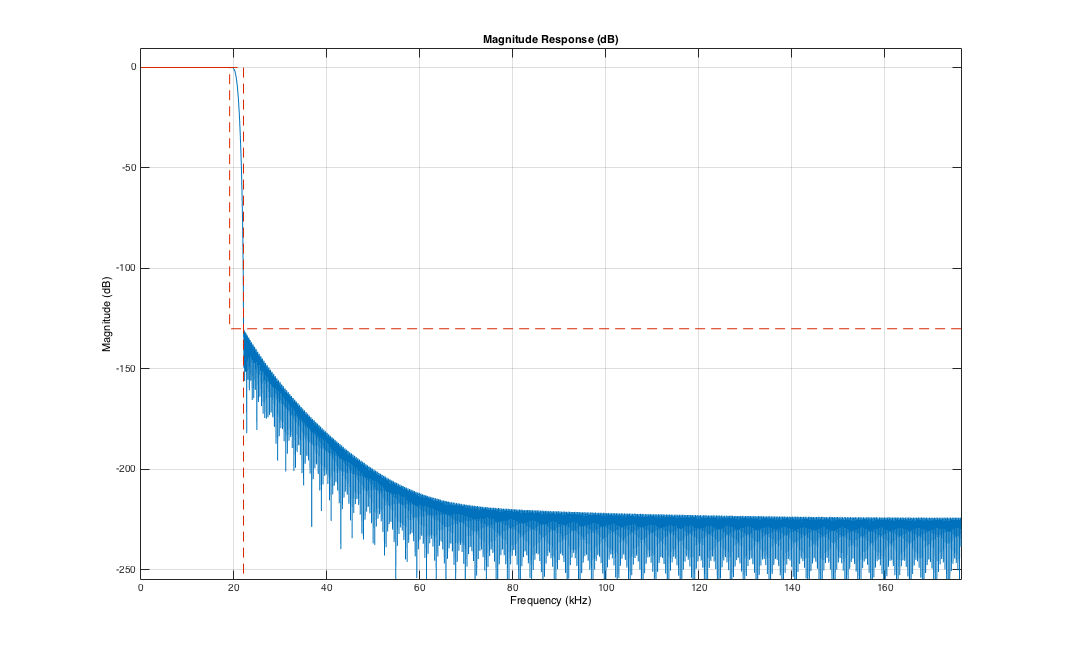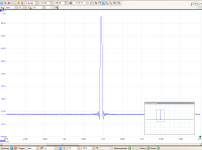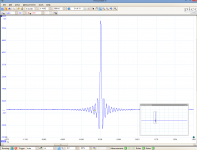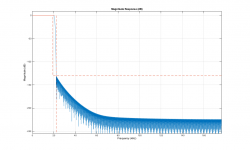Is the only good window no window?
zfe et al
I have the impression that the un-windowed filters actually sound quite different to those with kaiser/chebyshev/taylor/etc windowing.
After listening to the IFIR based filter I posted earlier and now some equiripple filters I've been playing around with to see how different they are in tap length, I'm noticing these "un-windowed" filters have a slightly more airy, open presentation.
The impression I get from listening is the windowed filters for ex. the SoX HiAtt and similar variants is they sound slightly softened/rounded when compared with the algorithm generated filters.
I'm finding that I'm getting shorter and steeper filters using the equiripple algorithm vs the IFIR designs converted to single stage, or the kaiserwindow method. For the same filter spec kaiserwindow is about 25% longer than the other two. I guess it isn't that surprising as the algorithms are designed to produce optimised filters that meet a given specification, whereas windowing is a "brute force" method.
I've attached an example, with the filter spec from matlab, .txt, and .skr...
Anyway I've just been doing some leisurely listening to this, and I think sounds fairly good, its very clean sounding, and as noted above makes the SoX HiAtt style filters sound a bit warm/soft/hazy, so could be verging on analytic for some tastes...
Anyway this is a bit of an experiment so would be interested in thoughts on how this sounds cf the other benchmark filters...
zfe et al
I have the impression that the un-windowed filters actually sound quite different to those with kaiser/chebyshev/taylor/etc windowing.
After listening to the IFIR based filter I posted earlier and now some equiripple filters I've been playing around with to see how different they are in tap length, I'm noticing these "un-windowed" filters have a slightly more airy, open presentation.
The impression I get from listening is the windowed filters for ex. the SoX HiAtt and similar variants is they sound slightly softened/rounded when compared with the algorithm generated filters.
I'm finding that I'm getting shorter and steeper filters using the equiripple algorithm vs the IFIR designs converted to single stage, or the kaiserwindow method. For the same filter spec kaiserwindow is about 25% longer than the other two. I guess it isn't that surprising as the algorithms are designed to produce optimised filters that meet a given specification, whereas windowing is a "brute force" method.
I've attached an example, with the filter spec from matlab, .txt, and .skr...
Anyway I've just been doing some leisurely listening to this, and I think sounds fairly good, its very clean sounding, and as noted above makes the SoX HiAtt style filters sound a bit warm/soft/hazy, so could be verging on analytic for some tastes...
Anyway this is a bit of an experiment so would be interested in thoughts on how this sounds cf the other benchmark filters...
Attachments
Last edited:
zfe et al
I have the impression that the un-windowed filters actually sound quite different to those with kaiser/chebyshev/taylor/etc windowing.
After listening to the IFIR based filter I posted earlier and now some equiripple filters I've been playing around with to see how different they are in tap length, I'm noticing these "un-windowed" filters have a slightly more airy, open presentation.
The impression I get from listening is the windowed filters for ex. the SoX HiAtt and similar variants is they sound slightly softened/rounded when compared with the algorithm generated filters.
I'm finding that I'm getting shorter and steeper filters using the equiripple algorithm vs the IFIR designs converted to single stage, or the kaiserwindow method. For the same filter spec kaiserwindow is about 25% longer than the other two. I guess it isn't that surprising as the algorithms are designed to produce optimised filters that meet a given specification, whereas windowing is a "brute force" method.
I've attached an example, with the filter spec from matlab, .txt, and .skr...
Anyway I've just been doing some leisurely listening to this, and I think sounds fairly good, its very clean sounding, and as noted above makes the SoX HiAtt style filters sound a bit warm/soft/hazy, so could be verging on analytic for some tastes...
Anyway this is a bit of an experiment so would be interested in thoughts on how this sounds cf the other benchmark filters...
Is it only me, but I'm finding that this particular filter make the sample rate locking clicks much softer than your other filters?
Not enough time to form a solid impression, yet, but I don't find it analytic at all.
Is it only me, but I'm finding that this particular filter make the sample rate locking clicks much softer than your other filters?
Not enough time to form a solid impression, yet, but I don't find it analytic at all.
Not exactly sure why some click more than others. I did think it might have been due to stop band attenuation reducing DC on the outputs but I can't see a clear correlation across the filters, so I'm not really sure.
Thanks for your effort. I think the filters have become so good that it is very difficult setting a winner. I guess it har become more of personal taste and system dependent whether we use headphones, big speakers, monitors, how well damped room, buffered or unbuffered outputs and so on.
Still my current favourite is the 1021filt_1013_C180_MP one...
But:
I dont have the all knowledge and resources that spzzzzkt has but have messed around with rephase for a while trying to brew some filters of my own. Been back and forth alot..
Linear Phase filters, minimum filters, mixed filters, trying more "advanced" filters, different windowings, centerings and so on
Today I settled an a very simple linear filter. Easy setup in rephase with 448dB/okt low-pass@20900hz. Nothing more and blackman-nuttall windowing.
To my surprise I really liked it. Seems in my setup quite dynamic and natural sounding.
Feel free to try.
Here are the measured (with scope) 5sample-sine impulse, 1sample-sqr impulse and doing a 20-22050hz swipe with flat-top windowing and "peak hold" setting so I can have a shot of bandwith measurement. (0-50khz)This is of course 16bit material.
The y-axis is not correct because limited resolution of the scope...
Still my current favourite is the 1021filt_1013_C180_MP one...
But:
I dont have the all knowledge and resources that spzzzzkt has but have messed around with rephase for a while trying to brew some filters of my own. Been back and forth alot..
Linear Phase filters, minimum filters, mixed filters, trying more "advanced" filters, different windowings, centerings and so on
Today I settled an a very simple linear filter. Easy setup in rephase with 448dB/okt low-pass@20900hz. Nothing more and blackman-nuttall windowing.
To my surprise I really liked it. Seems in my setup quite dynamic and natural sounding.
Feel free to try.
Here are the measured (with scope) 5sample-sine impulse, 1sample-sqr impulse and doing a 20-22050hz swipe with flat-top windowing and "peak hold" setting so I can have a shot of bandwith measurement. (0-50khz)This is of course 16bit material.
The y-axis is not correct because limited resolution of the scope...
Attachments
Last edited:
This is of course 16bit material....
I mean this is a very important point: while processing 16bit material, the filter/system/DAC should apply an 16 bit dither otherwise artifacts will be present.
just my 2 cents
Hp
There are fewer differences between new filters. But they sound and measured getting better than previous filters.
All new filters sound very nice, nothing annoying and when compared with the previous there are improvements.
I try to listen to songs that annoy me. There is a clear improvement in recent filters. I like NQ1008-C160-16-F2.
Another document on filter design.
http://www.vyssotski.ch/BasicsOfInstrumentation/SpikeSorting/Design_of_FIR_Filters.pdf
All new filters sound very nice, nothing annoying and when compared with the previous there are improvements.
I try to listen to songs that annoy me. There is a clear improvement in recent filters. I like NQ1008-C160-16-F2.
Another document on filter design.
http://www.vyssotski.ch/BasicsOfInstrumentation/SpikeSorting/Design_of_FIR_Filters.pdf
I mean this is a very important point: while processing 16bit material, the filter/system/DAC should apply an 16 bit dither otherwise artifacts will be present.
just my 2 cents
Hp
Dither is only meaningful when reducing word length to eliminate artefacts that would otherwise result from truncation. There is no truncation from higher word length to 16 bits taking place so dither at 16 bits is completely unnecessary.
The only dither that would possibly be required is at 28 bits, as there is truncation from the internal processing word length to 28bits for conversion in the R2R ladder. But that is at such a low level it's doubtful there would be any real benefit.
Most likely this would have no noticable effect. Some of my measurents I did with dithered/unditheed 24-bit test signals and saw no differences.The only dither that would possibly be required is at 28 bits, as there is truncation from the internal processing word length to 28bits for conversion in the R2R ladder. But that is at such a low level it's doubtful there would be any real benefit.
spzzzzkt:
thank you for your effort.
I have tried only the original, TotalCrap and 1013_C170_MP filter.
Each of them has its own merit.
I am now staying with C170_MP.
Maybe, I will try C170_LP sooner or later.
thank you for your effort.
I have tried only the original, TotalCrap and 1013_C170_MP filter.
Each of them has its own merit.
I am now staying with C170_MP.
Maybe, I will try C170_LP sooner or later.
spzzzzkt:
thank you for your effort.
I have tried only the original, TotalCrap and 1013_C170_MP filter.
Each of them has its own merit.
I am now staying with C170_MP.
Maybe, I will try C170_LP sooner or later.
The filters have been and still are a process of progressive development.
SoxHiAtt and 1021filt_1015_Kb16_BW are probably the filters I'd suggest if you aren't interested in experimental filters. I thought the C170_MP was a bit odd sounding, and zfe made similar comments. You would do well to try one of the two suggested above.
The filters have been and still are a process of progressive development.
SoxHiAtt and 1021filt_1015_Kb16_BW are probably the filters I'd suggest if you aren't interested in experimental filters. I thought the C170_MP was a bit odd sounding, and zfe made similar comments. You would do well to try one of the two suggested above.
Spzzzzkt, surely I will try the two suggested filters.
On first hearing, the C170_MP sounds a bit muddle compared with the original and TotalCrap. I believe that some magic of the DAC is loss. The merit is that it gives better bass response and sound more full body than the previous 2 filters.
BTW, is 1021filt_1015_Kb16_BW a typo? I can't find this filter in this thread.
Last edited:
I think it is in this post
http://www.diyaudio.com/forums/digi...lter-brewing-soekris-r2r-103.html#post4325278
http://www.diyaudio.com/forums/digi...lter-brewing-soekris-r2r-103.html#post4325278
too bright
My setup;
SDTrans384---> i2s dam 1021 --->unbuffed output ---> modulus-86 amp ---> Audio nirvana AlNico 8" full range speaker
All system (player, dac, amp ) powered by regulated psu.
i use SoxHiAtt filter atm.
This setup is good in jazz, vocal and acoustic musics.
But for the pop, rock alternative tracks it is too bright especially at vocals. And it disturbs and feels an annoying listening experience.
I do not know what is the reason maybe not filter or full range speakers maybe but at the end i listen very different type of musics so which filter do you suggest for me.
My setup;
SDTrans384---> i2s dam 1021 --->unbuffed output ---> modulus-86 amp ---> Audio nirvana AlNico 8" full range speaker
All system (player, dac, amp ) powered by regulated psu.
i use SoxHiAtt filter atm.
This setup is good in jazz, vocal and acoustic musics.
But for the pop, rock alternative tracks it is too bright especially at vocals. And it disturbs and feels an annoying listening experience.
I do not know what is the reason maybe not filter or full range speakers maybe but at the end i listen very different type of musics so which filter do you suggest for me.
An externally hosted image should be here but it was not working when we last tested it.
An externally hosted image should be here but it was not working when we last tested it.
An externally hosted image should be here but it was not working when we last tested it.
An externally hosted image should be here but it was not working when we last tested it.
I recommend:
NQ1008-C160-16-F2 (Brick Wall).
NQ_C128x110 (Cuasi-NOS)
I usually do tests with this music type and this filters is the least disturbs me. But the filter differences are small.
NQ1008-C160-16-F2 (Brick Wall).
NQ_C128x110 (Cuasi-NOS)
I usually do tests with this music type and this filters is the least disturbs me. But the filter differences are small.
Spzzzzkt, surely I will try the two suggested filters.
On first hearing, the C170_MP sounds a bit muddle compared with the original and TotalCrap. I believe that some magic of the DAC is loss. The merit is that it gives better bass response and sound more full body than the previous 2 filters.
BTW, is 1021filt_1015_Kb16_BW a typo? I can't find this filter in this thread.
No, there were two filters in an archive attached to this post:
http://www.diyaudio.com/forums/digi...ilter-brewing-soekris-r2r-21.html#post4325278
I prefer the Kb16_BW to the SoX Hi Att, tbh.
If you measure the response you'll find the bass is same in all the filters 🙂
It might not sound that way, however, because the MP in particular moves all the ringing energy after the main impulse. It has the effect of extending the decay of the impulse making the music sound "fatter". It's like turning up the reverb effect to add a bit of fatness and body to a recording. I don't think it's a particularly accurate reflection of the recorded audio, and it sounds a bit over done to my ears.
Well, the ringing only occurs around the corner frequency of the filter, so that is a 20kHz+ reverb 😀It might not sound that way, however, because the MP in particular moves all the ringing energy after the main impulse. It has the effect of extending the decay of the impulse making the music sound "fatter". It's like turning up the reverb effect to add a bit of fatness and body to a recording. I don't think it's a particularly accurate reflection of the recorded audio, and it sounds a bit over done to my ears.
Well, the ringing only occurs around the corner frequency of the filter, so that is a 20kHz+ reverb 😀
Looking at ringing is passé...
I'd recommend you have a read of Michael Pflaumer's patent linked earlier in the thread, in particular the use of log squared impulse response as the best representation of what we hear, and the way the shape of LSIR influences the perceived tonal balance.
Last edited:
The laws of physics evolve so fast, it is hard to stay fashionable 😉
Jocking aside, I will have a look, thank you.
Jocking aside, I will have a look, thank you.
That's EQuiripple not EQualizer...
just incase anyone was confused...
This is EQ_n011 and, no EQ_n002 -> EQn010 didn't go missing and yes, they were listened to.
This is an extension of the equiripple approach, with absolute attenuation traded for a shaped stop band. The stop band here rolls off at 60dB/oct from the -130dB point at 22050kHz. The filter will actually be quantised at around -170dB to -180dB but the slope adds very little to the cost of the filter in terms of taps. The result is that for most of the stop band the filter is at maximum possible attenuation.

just incase anyone was confused...
This is EQ_n011 and, no EQ_n002 -> EQn010 didn't go missing and yes, they were listened to.
This is an extension of the equiripple approach, with absolute attenuation traded for a shaped stop band. The stop band here rolls off at 60dB/oct from the -130dB point at 22050kHz. The filter will actually be quantised at around -170dB to -180dB but the slope adds very little to the cost of the filter in terms of taps. The result is that for most of the stop band the filter is at maximum possible attenuation.
Attachments
- Home
- Source & Line
- Digital Line Level
- Filter brewing for the Soekris R2R



